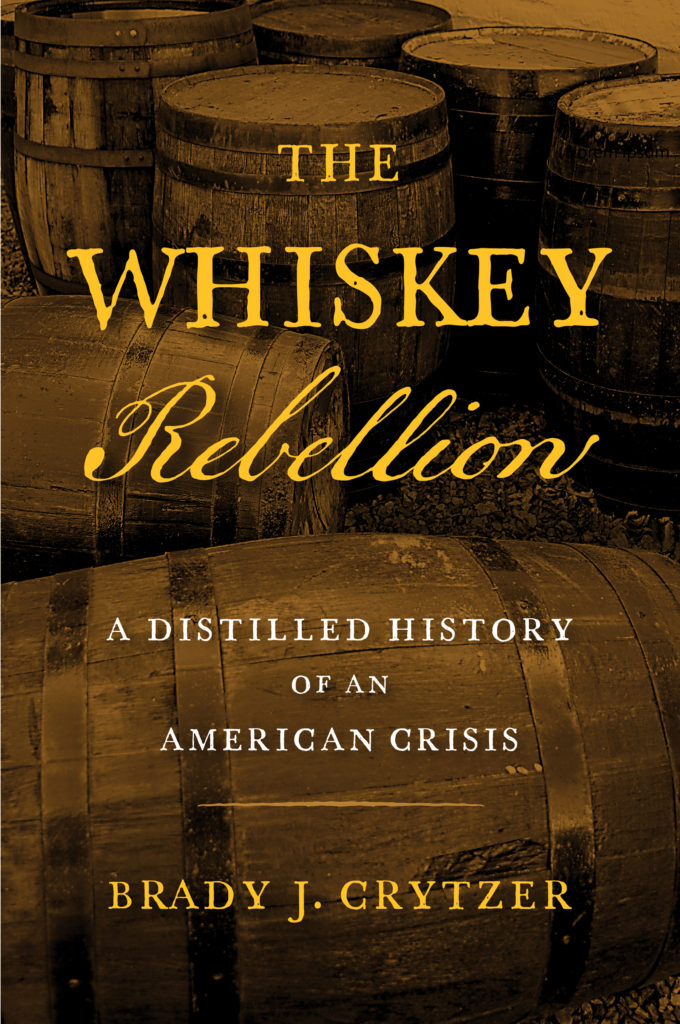

The Whiskey Rebellion
A Distilled History of an American Crisis
$30.00 Add to Cart Save 25% on every book by joining our Book Club


The largest insurrection against the US Government until the Civil War
In March 1791 Treasury Secretary Alexander Hamilton shocked the western frontier when he proposed a domestic excise tax on whiskey to balance America’s national debt. The law, known colloquially as the “Whiskey Act,” disproportionately penalized farmers in the backcountry, while offering favorable tax incentives designed to protect larger distillers. Although Hamilton viewed the law as a means of both collecting revenue andforcefully imposing federal authority over the notoriously defiant frontier, settlers in Western Pennsylvania bristled at its passage. They demanded that the law be revoked or rewritten to correct its perceived the injustices, and begged their representatives to lobby Congress on their behalf.
As the months passed however the people of Western Pennsylvania grew restless with the inadequacy of the government’s response and they soon turned to more violent means of political expression. Treasury officers across the west were targeted for their involvement in the tax collection, and they were brutally attacked by armed bands of disgruntled locals. They were tarred and feathered, burned with hot irons, and whipped; their homes were ransacked and burned. Extralegal courts were established in a direct challenge to federal authority, and the frontier slowly drifted toward a state of rebellion.
In response President George Washington raised an army of 13,000 men, one of the largest forces he ever commanded, to suppress the rebellion. No major battle ever occurred, but weeks of arrests, illegal detentions, and civil rights violations rocked the west. The event polarized the nation, and highlighted the dramatic differences between Washington’s Federalist perspective and Jefferson’s emerging Democratic-Republican Party. Two centuries later the Whiskey Rebellion stands as the second largest domestic rebellion in American History, only outdone by the Confederate States of America in 1861.
In The Whiskey Rebellion: A Distilled History of an American Crisis, historian Brady J. Crytzer takes the reader on a journey through Western Pennsylvania following the routes of both the rebels and the United States Army to place this important event into context for the reader. Complete with images and maps, the author illuminates what visitors can still see from the period while providing a cogent and engrossing account of this crisis unfolded and how it was resolved.

BRADY J. CRYTZER teaches history at Robert Morris University. He is the recipient of the Donald S. Kelly and Donna J. McKee Awards for outstanding scholarship in the discipline of history. A specialist in imperialism in North America, he is the author of a number of books, including Fort Pitt: A Frontier History, Guyasuta and the Fall of Indian America, and War in the Peaceable Kingdom: The Kittanning Raid of 1756. He is also the host of Dispatches: The Podcast of the Journal of the American Revolution.
“Crytzer’s nuanced narrative moves swiftly and surely over people, places, and events that might otherwise threaten to overwhelm the story of the Whiskey Rebellion. With the practiced eye of an experienced writer and historian, he introduces individuals with enough background and color to fix them in a reader’s mind without burying us in details that might distract. For those interested in visiting the area, he includes helpful location information about key places and buildings—some of which remain—where events took place. A healthy number of illustrations help flesh out the story. The Whiskey Rebellion is a must read for anyone who wants to understand frontier history and the ever-present potential for escalating resistance to the immoderate use of federal authority.”—Emerging Revolutionary War Era
“On Christmas Day 1794, an estimated 20,000 citizens lined the streets of Philadelphia to gawp and jeer as a score of bedraggled and shivering prisoners shuffled past under military escort. In the depths of winter, these wretched “rebels” had been marched 300 grueling miles across Pennsylvania from Pittsburgh to answer charges of treason against the United States. Their trials marked the culmination of the so-called Whiskey Rebellion, an armed defiance of federal authority that presented George Washington’s presidency with its gravest domestic challenge. President Washington had taken the threat so seriously that he authorized an army of 13,000 militia and, wearing his old blue and buff uniform from the Revolutionary War, personally led one of its wings toward the epicenter of unrest along the Ohio River in western Pennsylvania. As Brady J. Crytzer notes in “The Whiskey Rebellion,” his vivid account of what contemporaries called “the Western Insurrection,” this was a region with which Washington was familiar from his younger days fighting alongside the British during the French and Indian War. Indeed, one reason for Washington’s decision to take the field as commander in chief (the only sitting president ever to do so) was the threatening muster of 6,000 rebels at Braddock’s Field, near Pittsburgh, the site of a bloody defeat in 1755 from which, as an aide to Gen. Edward Braddock, he had been lucky to escape alive. . . . Crytzer grounds his engaging narrative upon intimate knowledge of the landscape where events unfolded, identifying locations linked with the insurgents and the troops sent against them.”—Wall Street Journal
“Crytzer’s fast-paced narrative of the Whiskey Rebellion elicits sympathy for nearly everyone involved—even the men in the middle, who sought the favor both of their frontier neighbors and elite politicians in Philadelphia. Some of these moderates took jobs as tax collectors. Others found themselves leading the insurgents. With this focus, Crytzer offers abundant fresh insight into what was arguably the greatest crisis of George Washington’s presidency.”—Woody Holton, author of Liberty Is Sweet: The Hidden History of the American Revolution
“By tracing the history of the “Whiskey Rebellion” through descriptions of existing sites and buildings, Crytzer gives us a layered view of our landscape and also of the ongoing, evolving, and very American contention between federal and populist power.”—Daniel Bullen, author of Daniel Shays’s Honorable Rebellion: An American Story